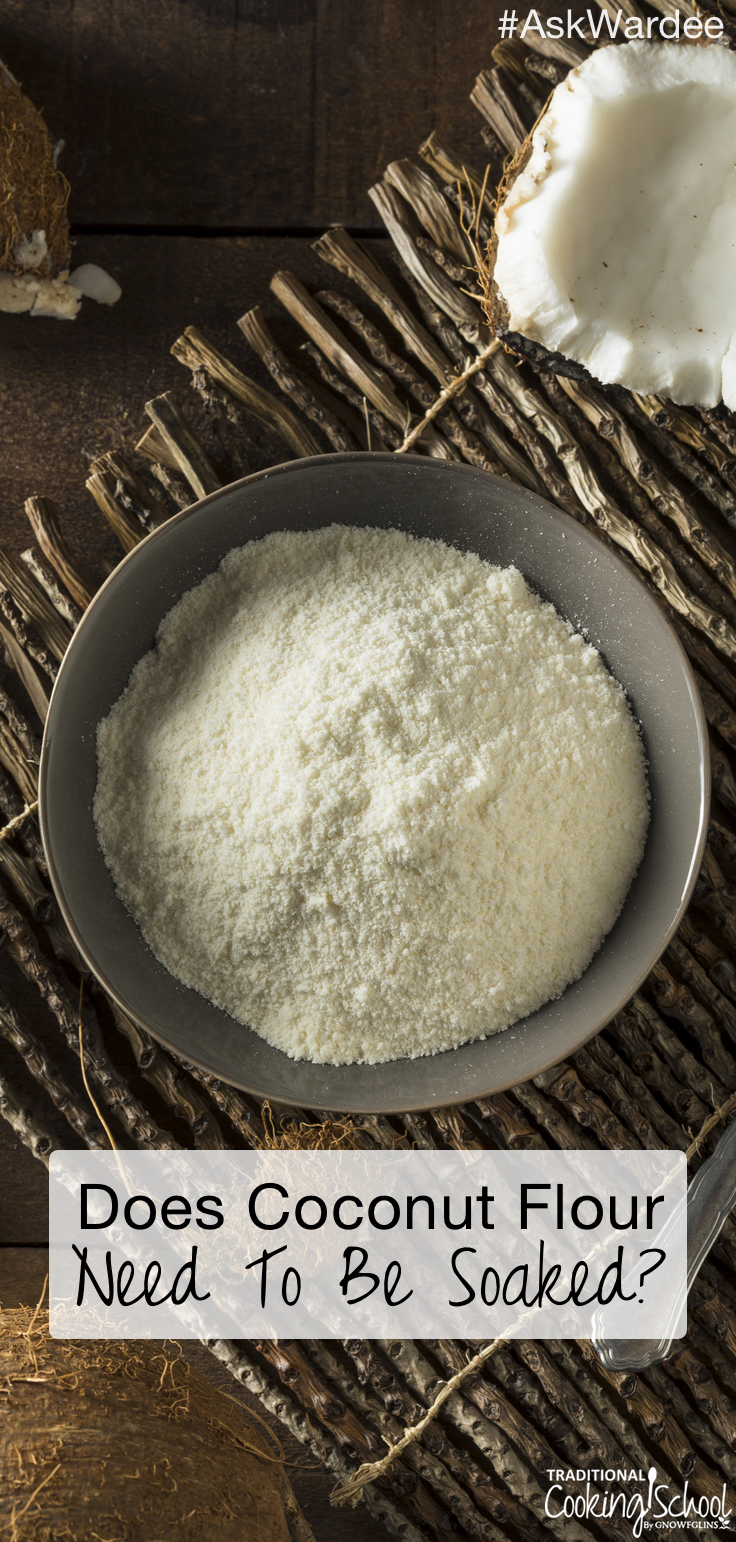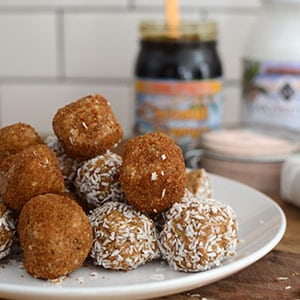
If you are baking with coconut flour, you may be wondering, “Does coconut flour need to be soaked?”
Does coconut flour contain phytic acid?
Well… coconut is a nut, right? And we all know that nuts and seeds do contain phytic acid and therefore should be soaked (here’s why and how!).
So at first glance, you might think — yes, coconut flour should be soaked, too.
The answer is not so simple, though…
Let’s dig a little deeper today on #AskWardee. 🙂
Plus, I’ll answer side questions from Ryan L. who is also wondering how to bake with it and if you can use coconut flour for breading.
I broadcast #AskWardee live each Wednesday at 10am Pacific (1pm Eastern) on Periscope and Facebook Live. Both the podcast and video replay of this week’s show are below. Enjoy!
Subscribe to #AskWardee on iTunes, Stitcher, YouTube, or the Podcasts app.
The Question: Should Coconut Flour Be Soaked?
Ryan L. asks:
What are your thoughts on using coconut flour for things like breading and baking? Would you soak it before using it? Does it contain a considerable amount of phytic acid? I’m very interested to hear your thoughts!
My Answer:
Before I give you the quick and easy answer, let’s first get on the same page…
What’s Coconut Flour?
Coconut flour is the dried meat of the coconut which is then ground into a powder. In general, coconut flour is lower in carbohydrates than grain-based flours, while it contains fiber, protein, and fat. It contains no gluten or grains (it’s a coconut!) which makes it a wonderful choice for gluten-free and grain-free baking. (It behaves very differently than normal flours though; see tips below.)
My favorite coconut flour is from Wilderness Family Naturals. It’s lighter and fluffier than others I’ve tried, it contains more fat (which gives a better texture and flavor) and I love that they take extra care when they make it:
Wilderness Family Naturals’ Coconut Flour is produced similarly to other coconut flours with a few exceptions: The organic coconuts are dried at low temperatures and when the dried coconut is pressed it is pressed slowly and carefully so no heat is generated and no “toasting” of the flakes occurs. You will notice that this organic coconut flour is white rather than the beige or light tan of other brands. Because of this gentle process, which generates little or no heat, there is slightly more oil in the coconut flour and more flavor. We find this preferable when making baked goods or making gluten-free mixes.
By the way…
Does Coconut Flour Contain Phytic Acid?
Phytic acid is what we call an anti-nutrient. Grains, nuts, and seeds contain it and when consumed untreated, the phytic acid binds with minerals in the digestive tract, preventing their absorption and use by our bodies. So it’s important to soak, sprout, or ferment (aka sour) these foods before eating them or baking with them.
And coconut does have phytic acid. However, as Bruce Fife N.D. points out here, this is not necessarily a bad thing:
Phytic acid occurs in nuts and seeds in two forms — phytic acid and phytic acid salts [Reddy, NR and Sathe, SK (Eds.) Food Phytates. CRC Press, 2001]. Both are generally referred to as “phytates.” Together, these two compounds make up the total percentage of phytates reported in various foods. However, they do not possess the same chelating power. So the chelating effect of the phytates in corn, wheat, or soy are not the same as those in coconut. You cannot predict the chelating effect based on total phytate content alone.
The mineral-binding effect of the phytates in coconut is essentially nonexistent. It is as if coconut has no phytic acid at all. In a study published in 2002, researchers tested the mineral binding capacity of a variety of bakery products made with coconut f lour. Mineral availability was determined by simulating conditions that prevail in the small intestine and colon. The researchers concluded that “coconut flour has little or no effect on mineral availability.” (Trinidad, TP and others. The effect of coconut flour on mineral availability from coconut flour supplemented foods. Philippine Journal of Nutrition 2002;49:48-57). In other words, coconut flour did not bind to the minerals.
Ok, so there is phytic acid but it’s the non-mineral binding form that makes it as if coconut flour doesn’t have phytic acid.
Does Coconut Flour Need To Be Soaked?
I think you already know the answer by now — no, it doesn’t need to be soaked.
Again quoting Bruce Fife N.D.:
Therefore, soaking or other phytic acid-neutralizing processes are completely unnecessary.
Soaking has been suggested as a means to reduce the phytic acid content in grains and nuts. Some suggest coconut flour should also be soaked. To soak coconut flour doesn’t make any sense. The coconut meat from which the flour is made, is naturally soaked in water its entire life (12 months) as it is growing on the tree. To remove the meat from the coconut and soak it again is totally redundant. After the coconut meat has been dried and ground into flour, soaking it would ruin the flour and make it unusable. You should never soak coconut flour.
In the tropics coconut has been consumed as a traditional food for thousands of years. Those people who use it as a food staple and regard it as “sacred food,” do not soak it or process it in any way to remove phytates. It is usually eaten raw. This is the traditional method of consumption. They apparently have not suffered any detrimental effects from it even though in some populations it served as their primary source of food.
The non-mineral-binding phytic acid issue aside, isn’t it interesting that the coconut meat is naturally soaked in its own water for a good 12 months? I love the beauty of God’s design. 🙂
How To Use Coconut Flour In Baking
So although you don’t have to soak it, you can’t just substitute coconut flour for regular flour and be good to go. It’s got… peculiarities. 😉
Though we have a whole coconut flour baking primer here, let me share the highlights of using it in baking:
Because it doesn’t have gluten to provide a binding structure when baked (basically so it holds together), you need to use a lot of eggs. Like 6 eggs for every 1/2 cup of coconut flour as a general rule. Also, you generally use less of it than regular flour and increase the liquids. This is because the high fiber content makes it very absorbent. It is amazing how absorbent coconut flour is!
Go here for the complete Coconut Flour Baking Primer.

Coconut Flour Recipes
In today’s broadcast, I’m showing off one of my favorite coconut flour recipes — these No-Bake Salted Caramel Cookie Dough Bites! (Pictured above.)
They use coconut flour, coconut oil, AND coconut syrup, and they’re absolutely scrumptious! The coconut syrup is what makes them awesome, so give the syrup a try if you can!
Here are some more of our favorite coconut flour recipes:
- No-Bake Salted Caramel Cookie Dough Bites — with WFN coconut flour, coconut syrup, and coconut oil!
- Grain-Free Mixed Berry Cobbler
- Paleo Chocolate Chip Cookie Brownies — with WFN coconut flour, coconut syrup, and coconut oil!
- Grain-Free, Maple-Pumpkin Chocolate-Dipped Cake Pops
- Grain-Free Salmon Patties with Lemon Sour Cream
- Paleo Double Chocolate Chunk Cookies
- Grain-Free Chocolate Cupcakes with Chocolate Buttercream Frosting
Using Coconut Flour As Breading
Ryan also asked if it was possible to use coconut flour as breading. Absolutely! I do it all the time.
I find it has a slightly more mealy texture, yet using Wilderness Family Naturals coconut flour turns out much better than other coconut flours I’ve tried. Like when dipping foods in regular flour, you want to shake off as much flour as possible so it can get crispy, not mushy.
I put some coconut flour is a shallow dish and season up just as I would normal flour. For a savory meal, I add sea salt, pepper, garlic, paprika, and cayenne pepper to the mix. Then, dip the food in beaten egg, coat with the coconut flour mixture, and fry. So tasty!
Helpful Links:
- 22% off PLUS free shipping on the exclusive Coconut Trio — Hurry! Thru Monday, May 1, 2017
- Coconut Flour Baking Primer
- No-Bake Salted Caramel Cookie Dough Bites — with WFN coconut flour, coconut syrup, and coconut oil!
- Grain-Free Mixed Berry Cobbler
- Paleo Chocolate Chip Cookie Brownies — with WFN coconut flour, coconut syrup, and coconut oil!
- Grain-Free, Maple-Pumpkin Chocolate-Dipped Cake Pops
- Grain-Free Salmon Patties with Lemon Sour Cream
- Paleo Double Chocolate Chunk Cookies
- Grain-Free Chocolate Cupcakes with Chocolate Buttercream Frosting
- Red Palm Oil from Wilderness Family Naturals — makes great just-like-the-theater popcorn!
Do you bake and cook with coconut flour? If so, please share your coconut flour experiences in the comments!
...without giving up the foods you love or spending all day in the kitchen!

2 free books:
Eat God's Way
Ditch the Standard American Diet, get healthier & happier, and save money on groceries...
We only recommend products and services we wholeheartedly endorse. This post may contain special links through which we earn a small commission if you make a purchase (though your price is the same).


Hey Wardee you may not have the answer to this but I would like to ask does coconut syrup have a high fructose/sugar content?
I use rice syrup for its no fuctose content. How does coconut syrup compare? Many thanks
Hi Angela,
Coconut sugar is 70-79% sucrose, followed by 3-9% glucose. The sucrose is about 1/2 fructose, making coconut sugar 38-48.5% fructose.
Hope this helps!
~Millie, TCS Customer Success Team
Thanks so much for this great article!
Botanically, the coconut is a drupe. A drupe is a type of fruit, that has a hard outer shell encasing the seed.